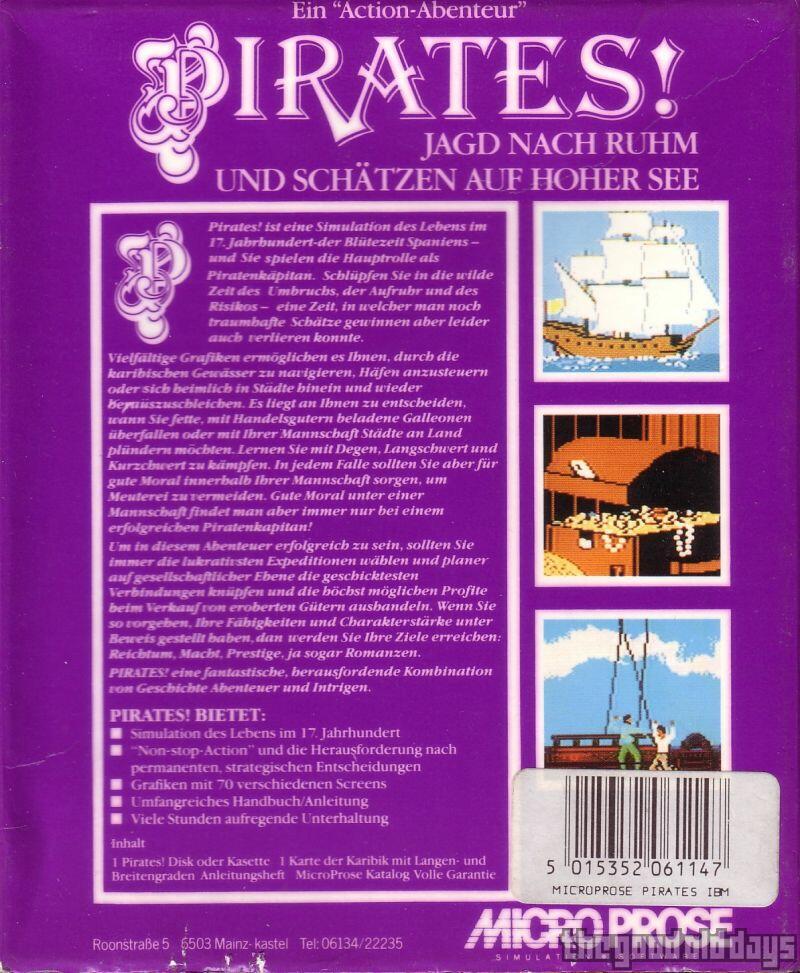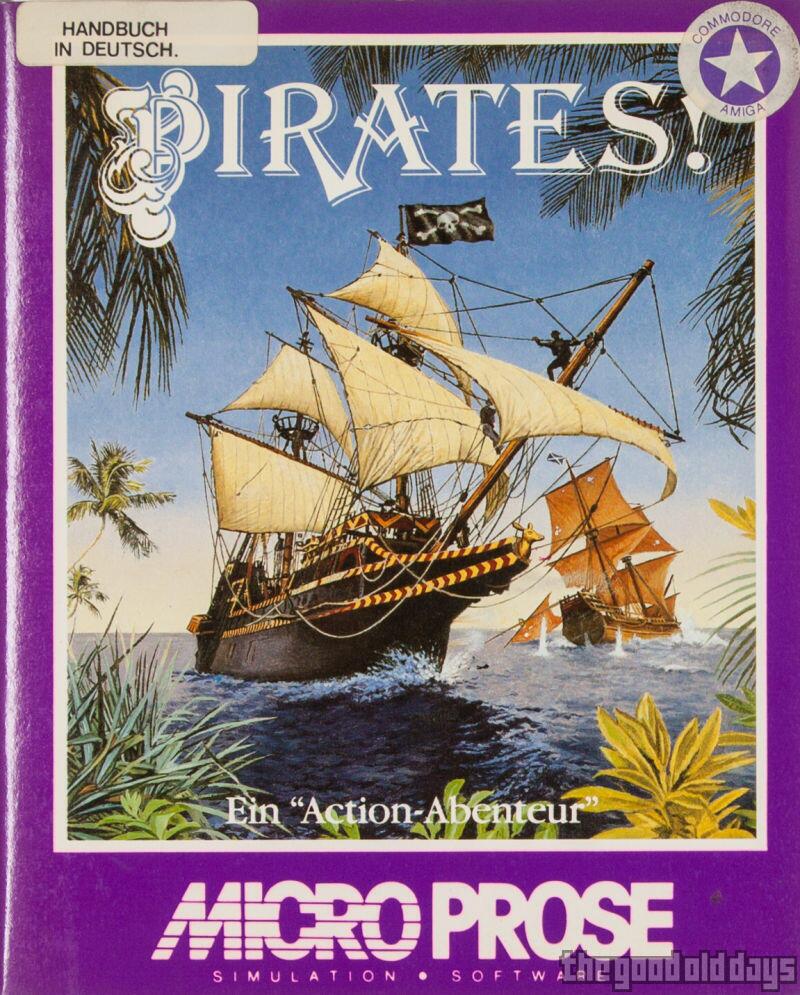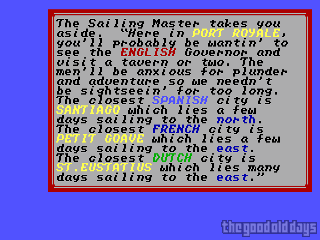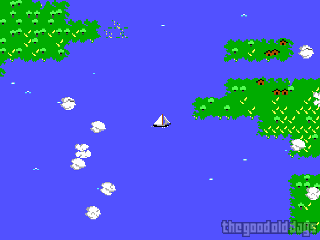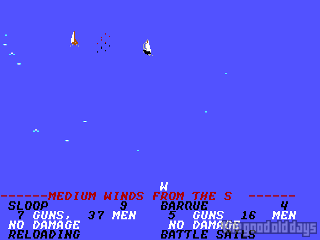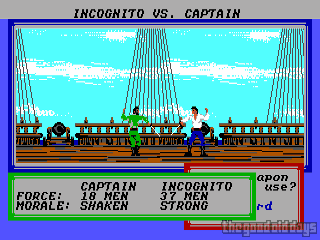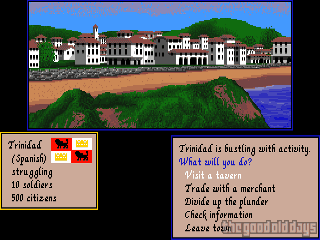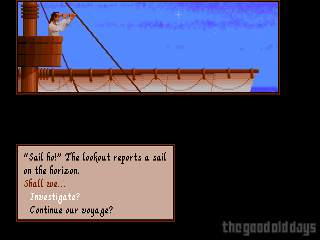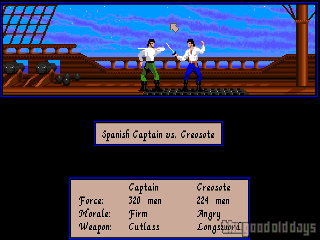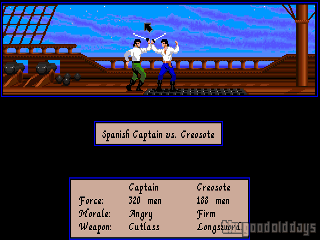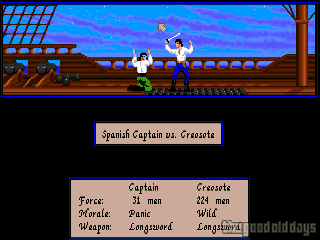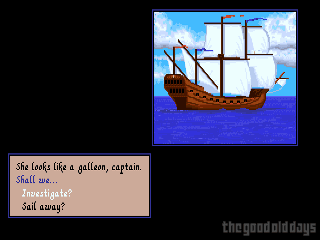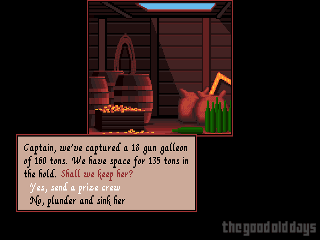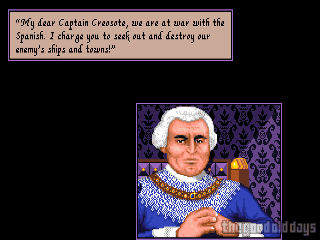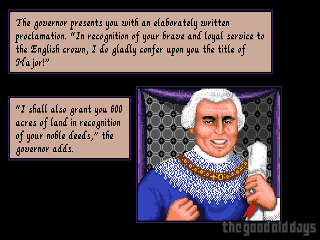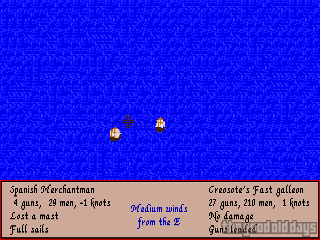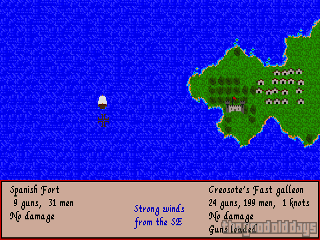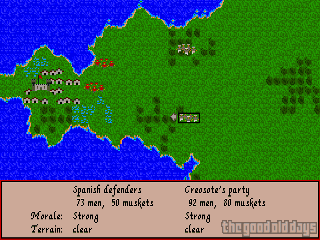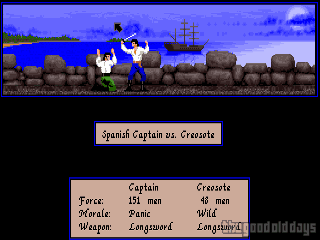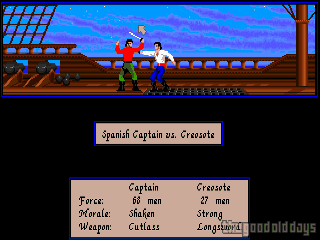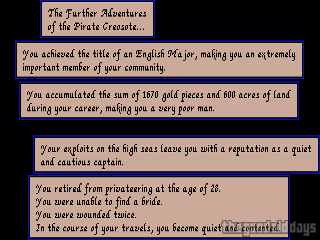Opinion Back Then
Pirates! is an impressive and absorbing game – one for those of you who enjoy getting all wrapped up in a strategy-style role-playing game with enough action to appeal to the arcadester.
Pirates! is an impressive and absorbing game – one for those of you who enjoy getting all wrapped up in a strategy-style role-playing game with enough action to appeal to the arcadester.
Every time Sid Meier has a wild card to really do exactly what he wanted, he came back to Johann Sebastian Bach . In the early/mid 1990s, after the massive, consecutive hits Railroad Tycoon and Civilization, he turned his appreciation for this composer into an ultra-obscure music application on the ultra-obscure 3DO console (C.P.U. Bach). Some years earlier, in the mid-80s, he had already built a strong name for himself with military simulations and wargames. Microprose’s overall business relying strongly on Meier, he played his first joker and – in a daring departure from his established genres – made Pirates!.

Even by Microprose standards, the Amiga port took exceedingly long, but after desperately waiting three years, this by then already legendary game hit the prosperous shores of the then most powerful home computer, and the Bach tunes accompanying the game never sounded better. And what was probably even more rewarding to Amiga users was the complete overhaul of the graphics; especially since the nemesis, the Atari ST, had received just a fairly lacklustre conversion just the year before, graphically still much too close to the original C64 version.
Music and graphics aside, Pirates! showed a far departure from what Microprose customers were used to from Meier (or any of their other designers). Escaping traditional genre boundaries, it is probably closest to the Cinemaware approach (Meier’s visit at the Cinemaware booth of a trade show just before is well documented): instead of starting design from a core gameplay mechanic, the game is designed around a theme. In this case, obviously, the romanticism of Hollywood style piracy.

Though where said Cinemaware usually launched their minigames based on an overall tightly written plot, Pirates! pioneered a different approach of open-ended gameplay used for emerging storytelling. So it is actually Elite, just on the seas? Again, to a degree, as sea battles, storming fortresses etc. shape the overall feeling, just like the encounters and discoveries did in the older game. Though where there, really all was happening in the player’s imagination, Meier did hide little snippets of actual plot here and there. Little plot threads which can be followed or not, this being totally left to the player.
Pirates! therefore occupies a noteworthy middle ground, hitting a sweet spot between guiding player experience, but nevertheless keeping it sufficiently open to allow for strong replayability due to variety. Whether you take your initial small ship looting and pillaging right away or whether you go for boarding other ships first to enlarge your own fleet or even do a little bit of peaceful trading first is left entirely up to you.
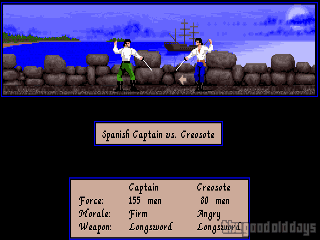
Even after initial build-up, what kind of pirate do you want to be? Commanding daring attacks against heavily guarded fortresses? Using a network of informers to spy out movements of the Spanish gold and silver transports to ambush them? Hunt for buried treasure in wilderness? Try to reunite the scattered family members (also, obviously, to get rich in the process)? If all this gradually falls into the “old hats” category, go play as a Spaniard in an age when essentially the complete Caribbean is Spanish, i.e. opportunities to plunder are somewhat… limited.
The mini games triggered fall into the simple and also rather easy to master bucket. Good fencing skills certainly make a difference, even making triumph possible when overall vastly outnumbered (ever had 300 armed men surrendering to you, standing alone?). Ship battles are straightforward, considering presence of cannons on board and the winds. Attacking fortresses from the sea side is probably the trickiest of the bunch, though luckily, approaching from the land side is also possible. In the latter case, the artificial intelligence controlling the defending army is (fortunately and unfortunately) overall unable to cope. Last, and in this case least, there is the sun sighting to determine current ship position on the open sea, which proved rather useless in the big picture and was even removed in subsequent versions.
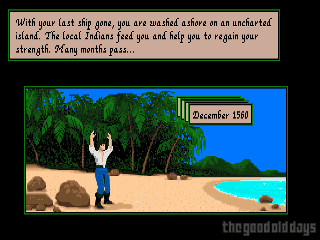
Meaning Meier’s intent with these mini games clearly was not to challenge too much, but rather for the player to take in the setting and live their own adventure. Even on failure, when imprisoned or one’s own ship sunk, the game actually goes on. Such interludes simply become part of said adventure and its narrative. Unless optimization obsessed players restore their previously saved state, that is. Though unlike Wing Commander, which attempted and failed at incorporating failure into the player’s personal narrative due to its strictly discrete mission structure which implicitly suggested the restoring route after failure, progress in Pirates! is much more fluid and continuous. Restoring a saved game almost always also means deleting a couple of nice to great experiences had in the meantime, so players have to think twice before doing this.
Finally, what further increases the lure to go on repeated adventuring is the underlying simulation of the changeable world. Although on overall simple terms, there are things happening regardless of player activity and performance. Wars are being declared, cities conquered, other pirates are attacking… Nation and city alignment therefore changes towards the player, their wealth goes up and down etc. If one thing is to be criticized, it is probably that the player’s influence on all of this is maybe even too strong. Experienced pirates would be quite able to turn the complete Spanish Main Dutch during their career, for example. Though considering how many trading games still using mostly static price charts were still being released for years to come following Pirates!, it’s quite an achievement already.

All that said, with two officially sanctioned upgrades available (Pirates! Gold from 1993 and Sid Meier's Pirates!: Live the Life from 2004), should you still play the original? Well, first of all, this game reviewed here isn’t the original either. Audiovisual differences aside, on the C64, you played with the joystick, this one supports the mouse. So in a way, it can actually be considered an intermediate step towards development of Gold. Minor tweaks of swordfighting and a slightly adapted map aside, that version is still the same game at heart, though. The later remake tried to infuse the game with a stronger explicit storyline (for better or worse) and new mini games (the dancing). Honestly, it is very likely a matter of subjective preference. It is quite likely at least that once everybody has found their preferred version, they will stick to this one. Jumping between the versions wouldn’t make a whole lot of sense. Personally, my recommendation is either this one or Gold on the PC. They look best (the newer one, ironically, loses here due to use of badly aged three-dimensionally rendered models), handle well and leave just the right amount of player freedom. No matter what version you pick: unspeakable riches (and true love) are just waiting for you!
Pirates! is surely one of the most well known computer games of all times. Almost every gamer who had a Commodore C64 will sigh when hearing the name. How many time have I spent in front of my home computer playing it? Months, I guess. How many ships have I sunk? Thousands maybe. I could continue this list even further.
What made Pirates so highly successful was on the one side the revolutionary game concept and on the other side infinite replayability. Brilliant sound (oh those wonderful Bach tunes…at least I think it was Bach) and good graphics completed the picture of the near-perfect game. Sadly graphics and sound suffered severely in the PC-conversion. Especially the noises coming out of the speaker are simply annoying and there’s obviously no way of switching them off. But gameplay is still very addictive.
At the start of the game you choose in which time period you want to play. From 1560–1680 there are 6 available. The most important difference in them is the Spanish domination level of the Caribbean. While in 1560–1620 most cities are in Spanish hands in later stages you can find more and more English, French or Dutch settlements which makes life much easier as you have more opportunities to recruit new crew members and sell your goods. Next you select one of the aforementioned 4 nationalities. Their respective governments provide different support for pirates so this adds to difficulty, too. But mainly the level is decided by four possibilites (from apprentice to swashbuckler) which not only have an influence on difficulty but also on the share you get when you divide your plunder. After typing in a fearsome name you can lastly choose one of five special skills. ‘Fencing’ makes you better in that (you’ll need that quite often), ‘Medicine’ gives you more constitution (longer career), ‘Charm’ has an influence on relations to governors and their daughters, ‘Gunnery’ gives you more accuracy in sea battles and ‘Navigaton’ lets you travel faster through the Caribbean.
The background story of your character is quite similar in all time periods and countries. By misfortune or pioneer spirit you come to the Caribbean to work on a plantation or a ship. By chance and skill you finally get to command a ship. You find yourself with a small vessel and crew and little money near a friendly town. Your first step should be to make a stop there.
In cities with 600 and more inhabitants you can visit the governor. He explains the political circumstances, hands out promotions and land as reward and you can meet his daughter (maybe your future wife?!). Sometimes he has some special missions for you like sinking a certain pirate or delivering a letter. You can also have a drink in the pub. There are always some unemployed swashbucklers available to increase your crew. Sometimes a rugged man is sitting in a corner and offering information about hidden treasures or cities. The bartender tells you the latest news. It’s important to watch them closely.
Example: You’re English and at war with Spain. The English governor rewards you for damaging the Spaniards. But suddenly a peace agreement is reached. So there’s no sense in sinking further Spanish ships as you won’t get any rewards any more. Or sometimes a wealthy city is struck by Malaria or Indian attacks which reduce their garrison. That could be the chance for a daring attack to capture vast amounts of gold. Another important building in a settlement is the merchant. He buys and sells goods and buys or repairs your ships. The city is also your only chance to save your game or dividing your plunder amongst the crew. You have to do this after a few unprofitable journeys when your men are getting unhappy or angry and start to desert in numbers taking part of your gold with them.
Leaving the city you find yourself somewhere in the Caribbean Sea. There are clouds wandering by which can have an effect on the direction of your fleet especially when you have bigger vessels. Near the coast you can often find shallows which you should evade at all costs with ships bigger than sloops as they could rip open their bottoms and sink them. So you cruise in front of enemy cities until you encounter a ship. After further identification (nationality or pirate) you decide whether to attack or flee.
Ship-to-ship combat is represented in a magnified map. Basically it’s most important to avoid the enemy’s salvos and to hit with yours. After some fights you will surely learn how to dance around the stern of your opponent and firing in salvo after salvo without getting harmed at all. You can either sink the other ship, damage it so badly that it surrenders or choose to enter it and to decide the battle in swordfight. There you see yourself and the enemy captain from the side.
You can hit or parry high, middle or low. Hits have an influence on the crew’s morale and a wild crew can even overcome a much bigger number of enemies when you fight very well and quick. After the battle you decide if you want to keep the ship or just plunder and sink it. Sometimes even enemy crew members offer their services to you.
You can attack enemy cities as well. While you can enter unfortified cities immediately towns with forts and more than 100 soldiers have to be forced to let you in. You can attack from the sea (quite similar to naval combat) or from land. There you command your units in real time and try to ambush the enemies in woods and so on. In certain Spanish cities at certain times of the year the famous Silver Train and Treasure Fleet can be found. As they transport vast amounts of gold they are valuable targets but unfortunately well protected. You need a large crew if you want to have a chance there. When you have overwhelmed the defenses very quickly or have a large crew compared to the town’s size you can install a governor of another country. Then this city can serve you as a base in the Caribbean.
Trade is handled very simplified in Pirates!. There are 3 trade goods: Apart from food for your crew there are a number of natural products (sugar, tabacco…) and luxury goods. By shipping goods to and natural products from big cities to smaller towns you can make quite some profit if you want to pursue a peaceful living.
But of course you can’t earn any fame with that and no fame means no titles. When you are promoted you learn about the whereabouts of certain Spanish villains who have some information about various familiy members of yours. When you find one and defeat him in a duel he gives you part of a map (similar to the treasure maps) of where to find your sister or uncle or others. And when you have found them they give you another map piece to an incredible Inca treasure (really huge amount of gold!). So that’s another goal you should try to achieve.
Well, I could write on for hours about this fantastic game but then there’s nothing left for you to find out yourself. I just can say: Go, get it and play one of the most fantastic computer games there ever was, there ever is and there ever will be! Two thumbs and all toes up!

